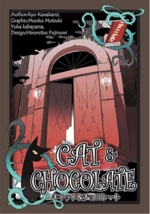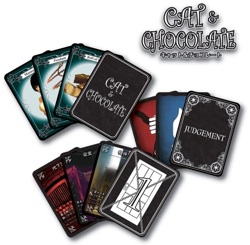
|
About OgreCave and its staff
|

|
by Lee Valentine
Japon Brand and Qvinta Essentia have released a new horror-themed storytelling card game, Cat & Chocolate (C&C). Unlike Once Upon a Time and similar games, here the stories aren't long, generally lasting just 30 seconds to two minutes each.
Gameplay There are two decks of cards in the game – object cards and event cards. At the beginning of the game a special event card marked "End" is inserted in the middle of the event deck. When it is drawn the game is over. Each player draws a hand of three object cards.
Each event card has a number on its back. The next event card (i.e., the one still on the top of the deck) tells you how many object cards you must play. The current player is in jeopardy from the event, but can tell a tale incorporating the required number of objects as key story elements to try to persuade the other players that he can escape his fate. After the story is told, the other players vote simultaneously as to whether the player escaped the harrowing event or whether he is doomed. If he escapes he keeps the event card as a point. Regardless, he draws back up to a hand of three total object cards. Play then rotates to the next storyteller. Once the "End" card is drawn from the event deck (usually after 20 to 30 minutes), the game ends and scoring begins. Players all reveal their current affiliation cards to discover who their teammates and opponents are. With four or six players, each team scores its total number of collected events. With five players the larger team only scores for the player with the most and the least number of collected events, with the smaller team scoring all their events. In a three-player game the solo player doubles his score to compare it to the number of events scored by the team of two. In the end, the team with the highest score wins.
Components The cards are bilingual in both English and Japanese. This gives the cards a slightly busy appearance, but the cards are all readable. There are occasional spelling and grammatical problems, such as an old man trying to "heart" himself instead of "hurt" himself. These translation errors rarely make the cards unplayable, but might be confusing for younger gamers. Also included are English and Japanese rulesheets. The object cards feature clean "clip art" style images surrounded by an elegant border. Most are not particularly horror-themed. The event cards name and depict rooms in The Haunted Mansion. They are shown in dilapidated condition, but only in one case is the threat written on the event card actually depicted in the art. While this makes the game more family friendly for younger gamers because there are no bloody chainsaws or naked succubi, the cards also contribute a bit less to the mood of the game as a result. The cards are packaged in a small sturdy box with a divider to keep the decks separate. The art on the box is somewhat more interesting and stylized than the art used on the object cards; it is more whimsical than the art on the event cards. I say this only because the box art isn't entirely reflective of the game's contents.
Conclusions The game is not perfectly balanced. For instance, it is entirely possible given the random insertion of the "End" event card and the random deal of the team cards that one team can end up getting to tell one or two more stories than the other team. Cat & Chocolate is a game I would recommend, but not a game to be played every day. It's so simple that it can appeal to gamer geeks and non-gamers alike. It's perfect for Halloween parties and gaming "get togethers" on a cool autumn night. If you play it with the right group it can be a lot of fun. While the game is somewhat group dependent, it's so silly it will help to get people in the right mood.
Lee's Ratings:
Links:
|
||
 Cat & Chocolate
Cat & Chocolate The first player starts the game by drawing an event card. The event
card tells you about an event inside The Haunted Mansion that your
character experiences. Some are trivial and not very horror-themed,
like your girlfriend calling to break up with you. Others are
traditional horror fare like an angry guy with a chainsaw.
The first player starts the game by drawing an event card. The event
card tells you about an event inside The Haunted Mansion that your
character experiences. Some are trivial and not very horror-themed,
like your girlfriend calling to break up with you. Others are
traditional horror fare like an angry guy with a chainsaw.